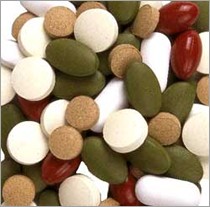DK Science & Technology: Chemical Industry
Plastics, AGROCHEMICALS, PHARMACEUTICALS, paints, and detergents are just a few of the products of the chemical industry. Chemicals are manufactured in huge chemical plants or extracted at OIL REFINERIES.
Chemicals found in nature, such as salt, sulfur, nitrogen, and natural gas, are the raw materials of the chemical industry. At a chemical plant, these materials are mixed, heated, and refined. The chemical reactions that take place transform the raw materials into acids, alkalis, and other valuable chemical compounds.
Sulfuric acid is made from sulfur, air, and water. It is the biggest single product of the chemical industry. It is used in batteries, dyes, detergents, fertilizers, and synthetic fibers. Other acids make rocket fuel, varnish, and explosives. Sodium carbonate is a common alkali used to make both soap and glass, for example.
Crude oil is extracted from under the seabed by offshore oil rigs. These enormous platforms are the largest sea-based structures in the world. Anchored to the seabed, the rig supports the drill and all the machinery needed to run the drilling operation.
Crude oil from oil fields around the world is shipped to refineries. The thick, black crude is not a single substance, but a mixture of many different carbon compounds (groups of atoms). At the refinery, the compounds are separated by fractional distillation.
At a refinery, crude oil is heated until it boils and turns into a mixture of vapors. Different compounds in the vapors cool and condense at different levels inside a tall distillation tower, allowing them to be separated out. Heavy industrial fuels condense at the bottom of the tower, lighter petroleum fuel at the top.
Using further treatments, lighter compounds can be turned into important fuels, such as gasoline and kerosene for motor vehicles and aircraft. They can also make fibers and plastics, solvents for paints, inks, adhesives, cosmetics, and pharmaceuticals. Heavier molecules are used for lubricant oils and bitumen.
Plants need minerals from the soil to grow well. But repeated use of soil drains the minerals from it and fewer crops are produced. The farming industry uses agrochemicals to help improve the quality of the soil, and also to fight off the insect pests, diseases, and weeds that would otherwise destroy their crops.
Because of the effect of artificial sprays and fertilizers on the environment, organic farmers choose not to use them. Instead, they use animal manure and compost, and rotate their crops with beans and peas to replace nitrogen in the soil. They also control pests with natural methods, such as planting onions between carrots to discourage carrot fly.
In the past, farmers tried to kill weeds with sea salt and other common chemicals. But these substances killed crops as well. Modern herbicides (weedkillers) are organic chemicals designed to limit weed growth. Many are selective, which means that they kill the weeds but do little harm to the crop.
A pharmaceutical is any substance used to treat or prevent disease. Since ancient times, people have experimented with plants as medicines, often poisoning themselves, but sometimes finding substances with real benefits—aspirin, for example. Today, the pharmaceutical industry is based on stricter scientific methods.

Most types of drug are taken orally (by mouth) in the form of tablets or pills, or as powders. Some drugs are swallowed in liquid form, and some are injected using a hypodermic syringe. Some drugs can also be absorbed through the skin.
Now that biochemists understand the chemicals in living cells, they can design molecules to combat illness. Molecules can be made in a laboratory and tested on cells in a culture (in vitro). Successful compounds are then tested on animals (in vivo).
When a drug has been tested in a laboratory, it is given to patients in tests called clinical trials. In these, some patients are given the new drug while others receive a placebo (a fake medicine). Because the patients do not know which one they have received, the test will show if the drug has a genuine effect.
